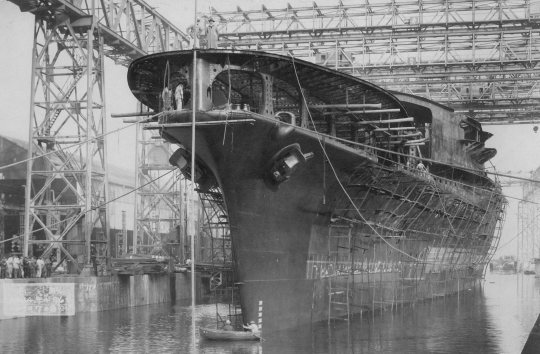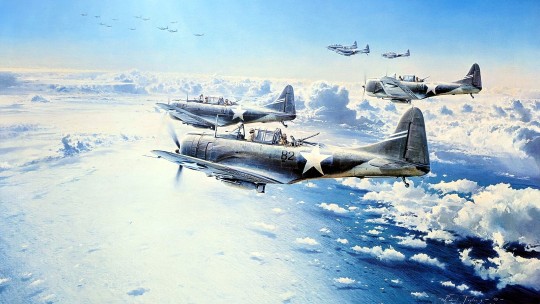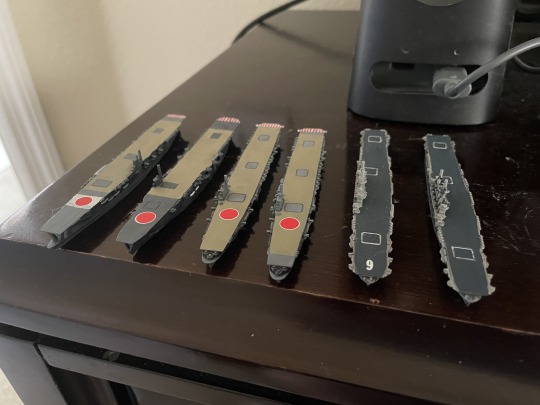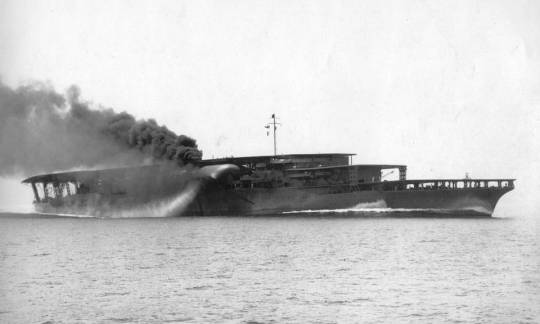#Japanese Aircraft Carrier Akagi
Text

"Aircraft prepare to launch from the Imperial Japanese Navy Aircraft Carrier Akagi (赤城, red castle) for the second wave of attacks on Pearl Harbor, Hawaii."
Photographed on December 7, 1941.
source
Colorized by Irootoko Jr: link
#Japanese Aircraft Carrier Akagi#Akagi#Japanese Aircraft Carrier#Imperial Japnese Navy#IJN#December#1941#Attack on Pearl Harbor#Pearl Harbor Attack#Pacific Ocean#colorized photo#colorized#my post
30 notes
·
View notes
Text

Porte-avions Akagi de la Marine Impériale Japonaise en cours de construction au chantier naval de Kure – Japon – 6 avril 1925
©Maritime History and Science Museum – Kure – Japan
#WWII#avant-guerre#pre-war#marine impériale japonaise#imperial japanese navy#ijn#marine militaire#military navy#marine de guerre#navy#porte-avions#aircraft carrier#classe amagi#amagi-class#akagi#chantier naval de kure#kure naval shipyard#kure#japon#japan#06/04/1925#04/1925#1925
37 notes
·
View notes
Text

Imperial Japanese Navy aircraft carrier Akagi under construction at Kure Shipyard, Japan. April 6, 1925.
16 notes
·
View notes
Text

The Japanese aircraft carrier Akagi at sea in October of 1934. Her flightdeck is loaded, containing an assortment of aircraft including Mitsubishi B1M and B2M aircraft.
Akagi was still equipped with three decks at this time (not easily seen in this particular photo). A year after this photo was taken, Akagi would undergo significant reconstruction at the Sasebo Naval Arsenal. During this reconstruction, she would receive vastly new equipment, oil-fired boilers, and a new island structure. However, the biggest modification saw her flight decks converted into one single flight deck of greatly increased size. This would enable her to operate newer aircraft that, while vastly more effective, were also larger and heavier than older designs.
16 notes
·
View notes
Text

Japanese Aircraft carrier Akagi in Kure naval shipyard on April 6th 1925
13 notes
·
View notes
Text
An Analysis of Imperial Japanese Navy Names as Used in Neon Genesis Evangelion
by @the-many-children-of-the-void
I have autism. I have a special interest in naval history, specifically the period between the launch of HMS Dreadnought in 1906 and the end of the Second World War. I know a lot of stuff, like the orders of battle for a bunch of actions in the Pacific. My favorite navy during this time period is that of Imperial Japan (mostly cause their ship names are the most fun). This basically makes me a member of the prime target demographic for understanding that particular bit of nuance.
As a side note: I'm going to try to refrain from using too much naval terminology in this essay but it's something I'm very close to and it's entirely possible that I end up like that one xkcd.
We're going to start with the Japanese aircraft carriers Akagi and Katsuragi and how their positions in the progression of Japanese carrier development lend themselves to their namesakes. Then we're going to discuss the Fubuki-class destroyer Ayanami and we're going to finish with a comparison of Soryu and Shikinami. I will not be discussing minor characters with ship names because, for the purposes of this discussion, they aren't relevant. Maya and Ibuki are both cruisers, for example, but there isn't really any special significance to those choices that I'm able to detect.
So what in the service histories of these ships leads me to suggest that their names have more specific significance than simply being names that go with their character's first names? That's the million dollar question and, by the time I'm done, I hope you'll at least understand where I'm coming from. So, buckle your seatbelts everyone and get ready for my hyperfixation fueled naval history infodump extravaganza.
We start with Akagi. She was built as the first full-size aircraft carrier in Japan, but she wasn't designed that. Prior to an international agreement to limit the size and number of ships in a number of navies, she was under construction as a battlecruiser (you don't have to know what that means), the second of the Amagi-class (a class is a set of ships that are all designed the same way). After that agreement was signed, though, Japan elected to convert her to an aircraft carrier instead of scrapping her hull. She served as a test bed for various aircraft carrier technologies during the 1930s and was modernized later in the decade. She served in the Kido Butai, Japan's strike force that attacked Pearl Harbor with another ship we'll see in a bit and was sunk at the Battle of Midway in 1942. For this comparison though, we need to meet another ship too.
Katsuragi was Akagi's opposite in a number of ways. She was designed as an aircraft carrier. She was completed in October of 1944. She was the second to last big aircraft carrier built by the Imperial Japanese Navy during the war. She was started to help replace the carriers lost at Midway. She never left port although, if she had, it would almost certainly have been to ferry kamikaze aircraft. Sound familiar?
Misato's role is the same. Bringing the sacrifice to the altar, in the same way an aircraft carrier bringing kamikaze aircraft does. It's reductive, though, to reduce Misato Katsuragi to just her relationship to Shinji, so let's look at her relationship to the character named for the other ship we've talked about: Ritsuko Akagi and, more specifically, how Akagi and Katsuragi apply to their characterizations and their relationship.
Katsuragi was young and fiery. She never saw action but her crew would have been young, mostly former students. She was indicative of an "ends justify the means" mindset in the latter half of the war. In contrast, Akagi was more cautious and experienced, a comparison reflected in any comparison of their namesake characters.
So the operational histories of Akagi and Katsuragi are reflected in their characters, but those are just two. Next, let's take a look at Ayanami, the lead ship of her subclass of Fubuki-class destroyers and why the choice of a destroyer from the middle of a class is relevant to Rei.
As we've established, a class of ships is a group of them that are all built to the same design. Japan built 24 Fubuki-class destroyers. By having so many, destroyers can be easily replaced with other ones. Not many destroyers attain fame equal to that of a bigger ship, such as a battleship or an aircraft carrier and they're not supposed to. They escort merchant ships, hunt submarines and serve as the screen for the bigger ships. Any fleet will have between a few and a bunch of destroyers. They're easy to replace. If one is sunk, another one can take its place.
This is the piss on the poor website, but I hope the point I'm building to is already obvious. For those to whom it isn't, let me make it clearer: Japan built 24 Fubuki-class destroyers. Destroyers are small ships and are easy to replace. Ayanami was the eleventh of those ships. Not the first Fubuki and not the last. The use of a destroyer name reflects that implication.
There's one more advantage to the choice to use Ayanami instead of another Fubuki-class ship that's going to become more relevant in the final part of this essay but I think it's important to mention before that point: Ayanami was the 11th, and the first of her subclass. The first child.
Now we're going to talk about how the meaning of Asuka's name changes depending on Soryu and Shikinami. It's all based on the orders of their construction in relation to the ships around them. We're going to start with Soryu.
Soryu was the third fleet aircraft carrier built in Japan, after Akagi and Kaga. She was the first purpose built fleet aircraft carrier after two prototypes. As Asuka says in Episode 8: Asuka Arrives in Japan:
After all, Units 00 and 01 were created as part of a development process, prototype and test type. The fact that it synchronized with an untrained pilot like you is proof of that. But Unit 02 is different. Created for actual combat conditions, this is the world's first true Evangelion.
Hmm. That sounds like how someone would describe Soryu, in relation to Akagi and Kaga, doesn't it? Soryu represents, in an obscure way, that Asuka is the pilot of Unit 02. But what about Shikinami? It's not an aircraft carrier. In fact, it's a destroyer, like Ayanami. It's a destroyer exactly like Ayanami. Ayanami is the 11th Fubuki-class destroyer and the first of the Ayanami subclass. Shikinami is the 12th Fubuki-class destroyer and the second of the Ayanami subclass. If Ayanami is the first child and the first of the Ayanami subclass, then Shikinami is the second child and the second of the Ayanami subclass.
So, Akagi and Katsuragi are indicative of their characters, based on their histories. Ayanami was a destroyer, something easily replaceable. Soryu and Shikinami are representative of Asuka's position, although the former is more subtle than the latter.
But Allie, I hear you say, how can you assign meaning to this? You've been in this fandom for four total days and you spent the first two of those watching it. How do you ascribe any intention here? The truth is, I can't. I can't say for certain any of this was intentional. The only reason I can think of to suggest it could have been was that it happens a lot. Hyuga doubling as a pilot, for example. Can I claim to know exactly what was going on in Anno's mind in the decade before I was born? Clearly not. Is it interesting and thought provoking to think about? Absolutely.
Thank you for taking the time to read this crap.
#nge#neon genesis evangelion#ritsuko akagi#misato katsuragi#rei ayanami#asuka langley soryu#asuka shikinami#naval history#naval warfare#sb writes
8 notes
·
View notes
Photo

1942 06 04 Midway, Turning of the Tide - Richard Taylor
This stunning aviation panorama vividly brings to life the minutes just prior to the Battle of Midway, the decisive battle that wrote the name of the SBD Dauntless dive-bomber into military history. The date was 4 June 1942; the time was 10.10 hours; and the place was 20,000 feet above the Pacific Ocean, 200 miles north-west of Midway Island. It was the calm before the storm. The Dauntless pilots are in luck; by a stroke of fortune they have found the Japanese carrier fleet at its most vulnerable, decks packed with aircraft re-fuelled, re-armed and almost ready for take-off, But as the Akagi, Kaga, Hiryo and Soryu begin to turn into the wind to range the flight decks for take-off, the unthinkable happens. Plummeting out of the skies above them came the SBD Dauntless dive-bombers, flown by many of the most experienced pilots in the US Navy. Within seconds they will devastate the Japanese fleet, destroying half of the entire enemy carrier force. It was the beginning of the end for the Imperial Japanese Navy.Midway turned out to be one of the most strategically decisive victories fought in the Pacific, and this truly great collector’s piece carries the signatures of four outstanding Dauntless pilots who flew in that historic Midway attack: Commander Dick Best, Captain Edward Anderson, Commander Don Ely and Rear Admiral Wilbur Roberts. This never-to-be-repeated combination of dramatic image, distinguished pilots and historical accuracy means that ‘Midway – Turning of the Tide’ is greatly sought after on the secondary market and can therefore reach high values.
72 notes
·
View notes
Note
the funniest part about that art to me is how epic it makes the US look when they got really fucking lucky at Midway, the water purifier trick to figure out where the japanese were gonna attack was smart, but the actual day of the battle? the coordination on the American side was awful. Montemayor on youtube has a moment by moment break down of the battle from the American side, but you've got Japanese scouts flying directly over the American forces and NOT SEEING THEM, you've got torpedo bombers, dive bombers and fighters all going in different directions, the flight to nowhere, Waldron DEFYING ORDERS to go in the correct direction, the different squads just HAPPENING to arrive in staggered waves unintentionally, and the 1st and 2nd dive bomber squads just happened to arrive at the same time for a massive final blow, while ALL of the japanese air patrol was distracted by the torpedo bombers and left the aircraft carriers almost defenseless, Best breaking off to target the Akagi when he noticed nobody was going after it, only America could make that look like brilliant tactical strategy
I fucking LOVE the Pacific theatre in WW2 but especially the first 6 months up to Midway because the US is just wildly incompetent the entire time and yet somehow, the Japanese manage to be so, so much worse. it's fucking incredible. Luigi wins not by doing absolutely nothing but by actively tripping and falling over his own feet while everyone else runs headfirst off a cliff.
#ask#anon#THERE'S SO MUCH MORE TO THIS THOUGH#i'm not gonna get into it here or i'd never shut up#but holy shit
18 notes
·
View notes
Note
Sorry, maybe because i just came from kancolle fanfic reading, but why are the Yamato sisters useless in the Azur lane world? Arent the Yamatos among the most heavily armed and reinforced units in the Japanese side? Or arethe jokes about hotel yamato on point for the ship girls?
Yeah, Kancolle will definitely skew your perspective even before the fanfic, lol.
The Yamato-class were on paper the greatest battleships ever, with the biggest guns and heaviest armor.
That was debatable already, but really didn't matter when the reality for most of the war was that battleships were nigh obsolete for ship to ship combat and completely ineffective to the Japanese war effort. The Yamato-class in particular were too expensive to deploy long-range due to dwindling supplies. For the most part they were kept close to the mainland out of submarine range.
Then things got worse.
Shinano was set to be converted into an aircraft carrier after Midway, but was too far along to become a full fleet carrier, so they settled on something close to a support carrier. She was sent out in desperation for a full fitting too early, and was sank en route by Archerfish.
Musashi was caught out on patrol by Intrepid and sank rather quickly, and Yamato - who was basically just a glorified propaganda piece - was ordered to beach herself on Okinawa and be a stationary artillery battery until she was destroyed completely, but didn't even make it that far before she was sank by aircraft.
All three of them utterly and completely useless paper tigers.
For AL specifically, they're shaping up to be the same in lore while being pretty good in gameplay.
As far as lore goes they're strong alright but Shinano's power is her dreams and she spends hardly any time awake and aware of where and when she is.
Musashi is majestic and imposing but indolent and pretty much latches onto Akagi because it gives her someone to support without her having to make the decisions. Her use begins and ends as Akagi's rubber stamp convincing people to follow her. When something comes to her specifically and threatens someone she cares for, she can be plenty menacing - but that doesn't really matter, especially not when Akagi's been granted god-tier power and has a plan already.
We know very little of Yamato, but what we do know is that she's as imposing as Musashi but "calming" to be around, and has been completely and utterly absent from the story despite all of the utterly insane bad shit we've seen. Not a stretch to assume she'll be similar to Musashi.
Even if you want to look at their lore strength and even if you're going to compare them solely to battleships in gameplay, the Black Dragon is around.
Technically Shinano wins as the most useful Yamato because her dreams verify Akagi's mindset and she's also the strongest carrier in the game when Big E doesn't proc her skill.

18 notes
·
View notes
Photo

"Pawn Takes Castle" by Tom Freeman. The Dauntless SBD is the "pawn," and the "castle" is the Imperial Japanese aircraft carrier Akagi—translation: "red castle." via ImaginaryWarships
14 notes
·
View notes
Text

"USS Enterprise (CV-6) steaming at high speed at about 0725 hrs, June 4 1942, seen from USS Pensacola (CA-24). The carrier has launched Scouting Squadron Six (VS-6) and Bombing Squadron Six (VB-6) and is striking unlaunched SBD aircraft below in preparation for respotting the flight deck with torpedo planes and escorting fighters. USS Northampton (CA-26) is in the right distance, with SBDs orbiting overhead, awaiting the launch of the rest of the attack group. Three hours later, VS-6 and VB-6 fatally bombed the Japanese carriers Akagi and Kaga."
NHHC: 80-G-32225
23 notes
·
View notes
Photo

Porte-avions Akagi de la Marine Impériale Japonaise (IJN)
©Artwork by Takeshi Yuki
#WWII#Artwork#Takeshi Yuki#Marine impériale japonaise#Imperial Japanese Navy#IJN#Porte-avions#Aircraft carrier#Akagi
123 notes
·
View notes
Text

From left to right: Akagi, Kaga, Shōkaku, Zuikaku, USS Enterprise, and USS Hornet
Akagi was originally designed as an Amagi-class battlecruiser. However, due to the Washington Naval Treaty, the Imperial Japanese Navy had to convert the two ships into aircraft carriers. Amagi was critically damaged in the 1923 Tokyo Earthquake, and was scrapped. Akagi would go on to serve as the flagship for the Attack on Pearl Harbor in 1941, before being sunk at the Battle of Midway in 1942.
Kaga was originally a Tosa-class battleship, who fate became ambiguous with the Washington Naval Treaty (her sister ship, Tosa, was completed as a target ship). With the scrapping of Amagi, it was decided to complete her as an aircraft carrier. She also sank at Midway.
Shōkaku and Zuikaku were built in the late 1930s, and took part in the Attack on Pearl Harbor, the Battle of the Coral Sea, the Guadalcanal Campaign, the Battle of Santa Cruz, and the Battle of the Philippine Sea. Shōkaku would sink due to damage inflicted by the submarine USS Cavella, while Zuikaku was sunk by carrier based bombers at the Battle of Leyte Gulf.
USS Enterprise was a Yorktown-class carrier, that went on to become the most decorated American ship in World War II, serving in the entire Pacific Theater. The Japanese claimed sinking her on three occasions, leading to her being called ‘the Grey Ghost’. Though she was decommissioned in 1947, the name continues on in the form of the first nuclear-powered carrier, and a planned Gerald Ford-class carrier.
USS Hornet was also a Yorktown-class carrier, best known for carrying the B-25 bombers used in the Doolittle Raid. She sank during the Guadalcanal campaign.
Models are from ModelsInMiniature on Etsy:
3 notes
·
View notes
Photo

Japanese aircraft carrier Akagi (赤城) on trials in 1927.
43 notes
·
View notes
Photo

The Battle of Midway was a major naval battle in the Pacific Theater of World War II that took place on 4–7 June 1942, six months after Japan's attack on Pearl Harbor and one month after the Battle of the Coral Sea.[6][7][8] The U.S. Navy under Admirals Chester W. Nimitz, Frank J. Fletcher, and Raymond A. Spruance defeated an attacking fleet of the Imperial Japanese Navy under Admirals Isoroku Yamamoto, Chūichi Nagumo, and Nobutake Kondō near Midway Atoll, inflicting devastating damage on the Japanese fleet. Military historian John Keegan called it "the most stunning and decisive blow in the history of naval warfare",[9] while naval historian Craig Symonds called it "one of the most consequential naval engagements in world history, ranking alongside Salamis, Trafalgar, and Tsushima Strait, as both tactically decisive and strategically influential".[10]
Luring the American aircraft carriers into a trap and occupying Midway was part of an overall "barrier" strategy to extend Japan's defensive perimeter, in response to the Doolittle air raid on Tokyo. This operation was also considered preparatory for further attacks against Fiji, Samoa, and Hawaii itself. The plan was undermined by faulty Japanese assumptions of the American reaction and poor initial dispositions. Most significantly, American cryptographers were able to determine the date and location of the planned attack, enabling the forewarned U.S. Navy to prepare its own ambush.
Four Japanese and three American aircraft carriers participated in the battle. The four Japanese fleet carriers—Akagi, Kaga, Sōryū, and Hiryū, part of the six-carrier force that had attacked Pearl Harbor six months earlier—were sunk, as was the heavy cruiser Mikuma. The U.S. lost the carrier Yorktown and the destroyer Hammann, while the carriers USS Enterprise and USS Hornet survived the battle fully intact.
After Midway and the exhausting attrition of the Solomon Islands campaign, Japan's capacity to replace its losses in materiel (particularly aircraft carriers) and men (especially well-trained pilots and maintenance crewmen) rapidly became insufficient to cope with mounting casualties, while the United States' massive industrial and training capabilities made losses far easier to replace. The Battle of Midway, along with the Guadalcanal campaign, is widely considered a turning point in the Pacific War.
https://en.wikipedia.org/wiki/Battle_of_Midway
9 notes
·
View notes
